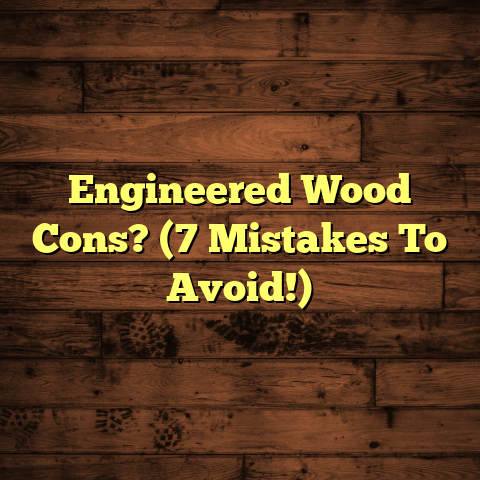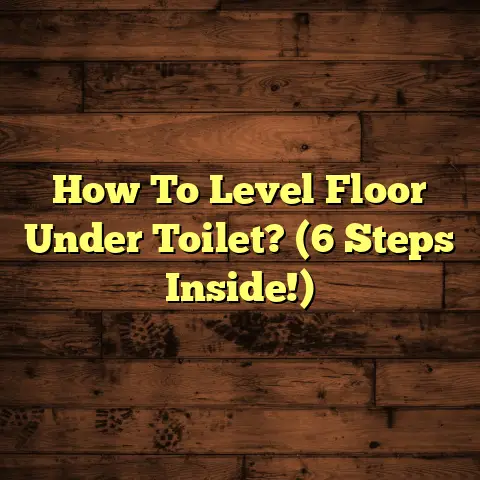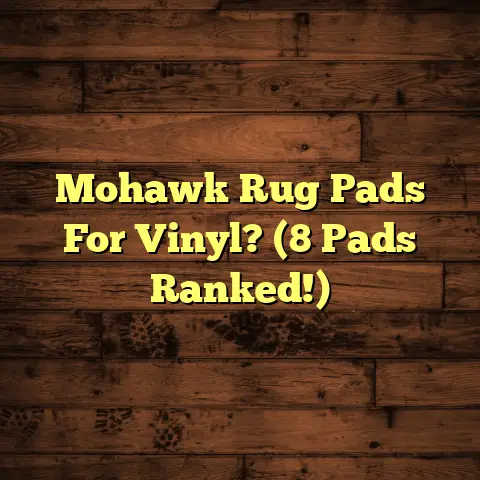Best Engineered Timber Flooring? (Top 5!)
As a flooring contractor with years under my belt, I’ve seen firsthand how the right flooring can transform a house into a home, season after season.
Think about it:
-
Spring: The freshness, the light pouring in – you want floors that feel clean and bright.
-
Summer: Barefoot days, easy living – durability and coolness are key.
-
Autumn: Warm hues, cozy nights – your floors should radiate comfort.
-
Winter: Battling the elements, seeking refuge – you need flooring that feels inviting and stands up to the wear and tear.
That’s where engineered timber flooring shines. It’s not just beautiful; it’s durable, versatile, and surprisingly easy to maintain. It’s a fantastic option for homeowners who want the look of real wood without the hefty price tag or some of the maintenance headaches.
In this article, I’m going to walk you through my top five engineered timber flooring picks, each one chosen for its ability to enhance your home throughout the year. Let’s dive in!
Section 1: Understanding Engineered
Timber Flooring
So, what exactly is engineered timber flooring? It’s a question I get asked all the time.
Simply put, it’s a type of flooring made from multiple layers of wood veneer, pressed together to create a stable core. This core is then topped with a layer of real hardwood, giving you the look and feel of solid timber.
How It Differs
Here’s a quick breakdown of how it stacks up against the competition:
-
Solid Hardwood: This is the real deal – planks made from a single piece of wood. It’s beautiful, but it can be prone to warping and expanding in humid conditions. It’s also generally more expensive than engineered timber.
-
Laminate Flooring: This is a synthetic material that mimics the look of wood. It’s cheaper than both solid hardwood and engineered timber, but it doesn’t have the same warmth or feel. Plus, it’s not as durable.
The Construction
Engineered timber flooring is like a well-built sandwich:
-
Top Veneer (Wear Layer): This is the real hardwood layer that you see and walk on. The thicker the wear layer, the more durable the flooring and the more times it can be sanded and refinished.
-
Core: This is the heart of the flooring, typically made from plywood, MDF (medium-density fiberboard), or HDF (high-density fiberboard). The core provides stability and prevents the flooring from warping.
-
Backing: This is the bottom layer, which provides additional stability and helps to protect the core from moisture.
The Benefits
Why choose engineered timber, you ask? Here’s a few reasons:
-
Stability: Engineered timber is much more stable than solid hardwood, meaning it’s less likely to warp or expand in varying humidity levels. This makes it a great choice for bathrooms, kitchens, and basements.
-
Eco-Friendliness: Because it uses less solid wood than traditional hardwood flooring, engineered timber is a more sustainable option.
-
Variety: You can find engineered timber in a huge range of wood species, finishes, and styles. Whether you’re after a rustic oak or a sleek maple, there’s an engineered timber option for you.
-
Installation: Many engineered timber floors can be installed as a “floating floor,” meaning they don’t need to be glued or nailed down. This makes installation easier and faster.
Where to Use It
Engineered timber is incredibly versatile and can be used in just about any room in your house. I’ve seen it used beautifully in:
- Living rooms
- Bedrooms
- Dining rooms
- Kitchens
- Hallways
- Even basements (with the proper moisture barrier, of course)
It’s also a popular choice for commercial spaces like offices and retail stores, thanks to its durability and stylish appearance.
Section 2: Criteria for Selecting the
Best Engineered Timber Flooring
Okay, so you’re sold on engineered timber. Great! But how do you choose the right one?
With so many options on the market, it can feel overwhelming. That’s why I’ve put together a list of key factors to consider:
-
Thickness and Wear Layer: As I mentioned earlier, the wear layer is the top layer of real hardwood. The thicker the wear layer, the more durable the flooring and the more times it can be sanded and refinished.
- Generally:
- 2mm-3mm wear layer: Good for moderate traffic areas.
- 4mm or more: Ideal for high- traffic areas and commercial spaces.
- Generally:
-
Wood Species and Finish: The species of wood will affect the look and feel of your flooring, as well as its durability. Some popular options include:
- Oak: A classic choice that’s durable and versatile.
- Maple: A lighter-colored wood that’s known for its smooth grain.
- Hickory: A very hard and durable wood with a rustic look.
- Walnut: A rich, dark wood that adds a touch of elegance.
The finish will also affect the look and feel of your flooring, as well as its resistance to scratches and stains. Common finishes include:
- Polyurethane: A durable, water-resistant finish.
- Oil-based: A natural finish that enhances the wood’s grain.
- UV-cured acrylic: An exceptionally durable finish that is scratch and wear resistant.
-
Installation Methods: Engineered timber can be installed in a few different ways:
- Floating: The planks are clicked together and “float” over the subfloor. This is the easiest and most common method.
- Glue-Down: The planks are glued directly to the subfloor. This method provides a more stable and permanent installation.
- Nail-Down: The planks are nailed to the subfloor. This method is typically used for solid hardwood, but it can also be used for some types of engineered timber.
-
Acclimation and Maintenance: Before you install your engineered timber flooring, it’s important to let it acclimate to the humidity levels in your home. This will help to prevent warping or expanding after installation.
As for maintenance, engineered timber is relatively easy to care for. Just sweep or vacuum regularly and mop with a damp cloth as needed. Avoid using harsh chemicals or abrasive cleaners, as these can damage the finish.
-
Environmental Certifications: If you’re concerned about the environmental impact of your flooring, look for products that are certified by organizations like:
- FSC (Forest Stewardship Council): This certification ensures that the wood comes from responsibly managed forests.
- CARB (California Air Resources Board): This certification ensures that the flooring meets strict standards for formaldehyde emissions.
Seasonal Considerations
Now, let’s talk about how these criteria relate to seasonal changes. Temperature fluctuations and humidity levels can have a big impact on flooring performance.
-
In the summer: High humidity can cause solid hardwood to expand and warp. Engineered timber is much more stable in these conditions, making it a better choice for summer homes or areas with high humidity.
-
In the winter: Dry air can cause wood to shrink and crack. Again, engineered timber is less susceptible to this than solid hardwood.
When choosing engineered timber, consider the climate in your area and how it might affect your flooring. For example, if you live in a very humid climate, you’ll want to choose a product with a stable core and a durable finish.
Section 3: Top 5 Best Engineered
Timber Flooring Options
Alright, let’s get to the good stuff! Based on my experience, here are my top five engineered timber flooring picks, each one chosen for its quality, durability, and seasonal suitability:
1. [Brand/Model Name]:
Armstrong Flooring –
Performance Plus Hardwood
-
Description: This engineered hardwood boasts a beautiful, natural look with a wide range of wood species and stain options. It’s designed for high-traffic areas and offers excellent scratch and stain resistance.
-
Specifications:
- Thickness: 3/8 inch
- Wear Layer: 2mm
- Installation Methods: Floating, glue-down, nail-down
- Environmental Certifications: CARB-compliant
-
Pros:
- Wide range of styles and finishes
- Durable and scratch-resistant
- Easy to install
- Relatively affordable
-
Cons:
- Wear layer is not as thick as some other options
- May not be suitable for very high-moisture areas
-
Seasonal Suitability: This flooring holds up well in most climates, making it a good choice for year-round use. Its scratch resistance is especially beneficial during the winter months, when you’re more likely to track in dirt and debris.
-
Price Range: \$3 – \$6 per square foot
2. [Brand/Model Name]:
Shaw Floors – Repel Water
Resistant Hardwood
-
Description: Shaw’s Repel engineered hardwood is designed with water resistance in mind. It features a unique coating that repels spills and stains, making it ideal for kitchens, bathrooms, and other areas where moisture is a concern.
-
Specifications:
- Thickness: 1/2 inch
- Wear Layer: 3mm
- Installation Methods: Floating, glue-down
- Environmental Certifications: CARB-compliant
-
Pros:
- Excellent water resistance
- Durable and long-lasting
- Stylish and modern designs
- Easy to clean
-
Cons:
- Can be more expensive than other options
- Limited style options compared to some other brands
-
Seasonal Suitability: This flooring is perfect for the spring and summer months, when you’re more likely to be dealing with spills and moisture. It’s also a good choice for homes in humid climates.
-
Price Range: \$5 – \$8 per square foot
3. [Brand/Model Name]:
Mannington – ADURA®Max Apex
-
Description: Mannington’s ADURA®Max Apex line offers the look of real hardwood with the added benefit of being waterproof. It’s made with a rigid core that provides exceptional stability and prevents warping, even in wet conditions.
-
Specifications:
- Thickness: 8mm
- Wear Layer: 20 mil (0.5mm)
- Installation Methods: Floating
- Environmental Certifications: FloorScore® certified
-
Pros:
- 100% waterproof
- Extremely durable and scratch- resistant
- Easy to install and maintain
- Realistic wood look
-
Cons:
- Limited style options
- Can feel slightly harder underfoot than traditional engineered timber
-
Seasonal Suitability: This flooring is ideal for all seasons, but it’s especially well-suited for winter, when you’re more likely to be tracking in snow and slush. Its waterproof design will protect your floors from moisture damage.
-
Price Range: \$4 – \$7 per square foot
4. [Brand/Model Name]:
Bruce – Dundee Plank
-
Description: Bruce is a well-known name in the flooring industry, and their Dundee Plank engineered hardwood is a solid choice for homeowners looking for a classic, timeless look. It features a traditional oak design with a range of stain options to complement any décor.
-
Specifications:
- Thickness: 1/2 inch
- Wear Layer: 2mm
- Installation Methods: Floating, glue-down, nail-down
- Environmental Certifications: CARB-compliant
-
Pros:
- Classic and timeless design
- Durable and long-lasting
- Easy to install
- Affordable
-
Cons:
- Wear layer is not as thick as some other options
- May not be suitable for very high-moisture areas
-
Seasonal Suitability: This flooring is a good all-around choice for any season. Its classic oak design complements both warm and cool color palettes, making it easy to adapt your décor to the changing seasons.
-
Price Range: \$3 – \$5 per square foot
5. [Brand/Model Name]:
Somerset – Color Strip Collection
-
Description: Somerset’s Color Strip Collection offers a unique and stylish look with its narrow plank design and a variety of color options. It’s made with high-quality materials and features a durable finish that resists scratches and stains.
-
Specifications:
- Thickness: 3/8 inch
- Wear Layer: 2mm
- Installation Methods: Nail-down, glue-down
- Environmental Certifications: FSC-certified
-
Pros:
- Unique and stylish design
- Durable and scratch-resistant
- Made with high-quality materials
- FSC-certified
-
Cons:
- Installation can be more difficult than with floating floors
- Can be more expensive than other options
-
Seasonal Suitability: This flooring is a great choice for the autumn months, when you’re looking to add warmth and texture to your home. Its narrow plank design creates a cozy and inviting atmosphere.
-
Price Range: \$6 – \$9 per square foot
Conclusion
Choosing the right flooring is a big decision, but I hope this article has helped to narrow down your options. Engineered timber flooring offers a fantastic combination of beauty, durability, and versatility, making it a great choice for any home.
Remember to consider your specific needs, preferences, and seasonal considerations when making your decision. Think about the climate you live in, the amount of traffic your floors will be subjected to, and the overall look and feel you’re trying to achieve.
And don’t be afraid to ask for help! A professional flooring contractor can provide valuable advice and guidance to ensure that you choose the perfect flooring for your home.
Now, I’d love to hear from you! Have you had any experience with engineered timber flooring? What are your favorite seasonal decorating tips? Share your thoughts in the comments below!





